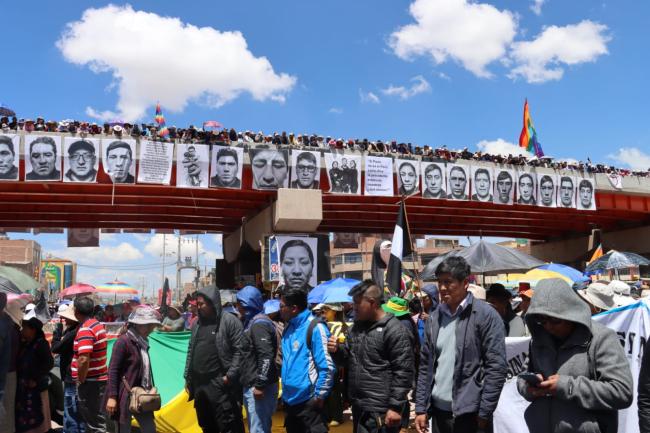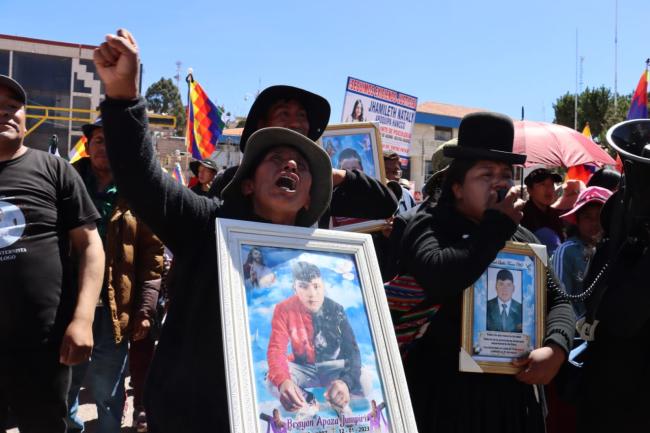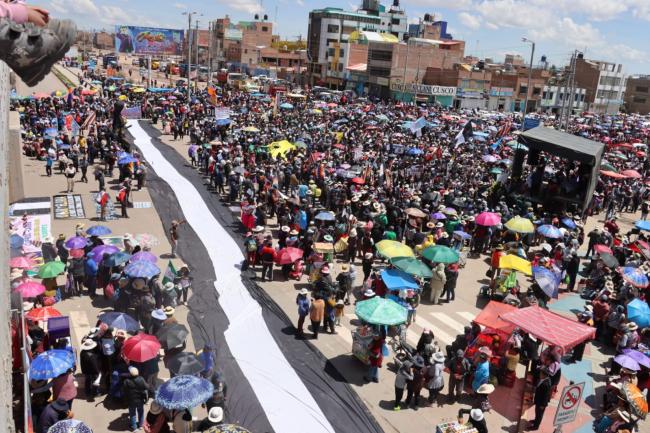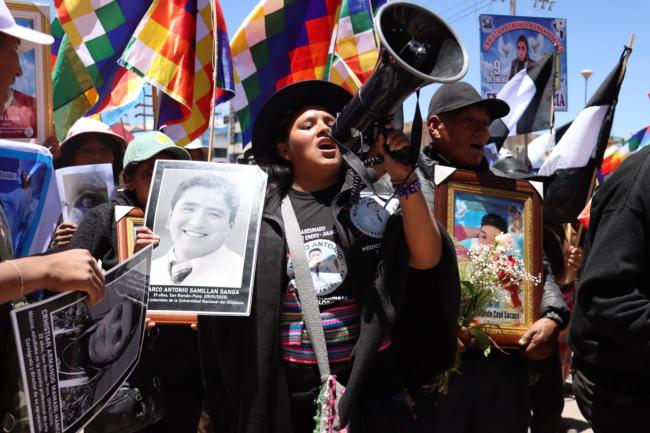January 9 marks one year since the massacre in Juliaca, when 19 campesino and Indigenous protestors were killed by state forces as they joined mobilizations taking place in some of the most impoverished provinces of the country. A small provincial town near Lake Titicaca in southern Peru, Juliaca was just one of a number of provincial towns that had experienced state-led massacres between December 2022 and February 2023. During that period, at least 49 people were killed, and dozens were injured by government forces.
Although the hegemonic discourse in Peruvian state politics remains obsessed with combating corruption, many analysts have long questioned its instrumentalization as a form of coercion to preserve the status quo. Perhaps nowhere is this more self-evident than in the fact that, a year on, not a single police officer or government official has been charged with a crime for openly killing dozens of protestors.
In December of 2022, Indigenous and campesino communities organized road blockades and airport takeovers as part of a popular rebellion in response to the arrest of former President Pedro Castillo. The former president had finally succumbed to the numerous efforts organized by his political opponents to topple his regime since narrowly winning the office in 2021. While the initial focal point was Castillo’s arrest, the ouster of the first “provincial president” was seen by Indigenous people as just one of the latest affronts to their dignity and humanity that runs deep throughout Peruvian history.
Since the events of December 2022, the country has experienced periodic episodes of unrest throughout the countryside as well as national mobilizations. While a number of these mobilizations from the peripheral provinces have brought thousands of peoples to the streets of Lima, they failed to garner much support from urban-based Limeños. The reluctance of Lima’s civil society to join mobilizations for justice and dignity for Indigenous peoples over the last year can be attributed to the long historical divide between the provinces of Peru and the capital, a divide that has become more acute over the last year.

The Two Perus
The dismissal of Andean and provincial grievances by the influential criollo civil society in Lima is a testament to the tenuous relationship that has long existed between what has historically been described as the two Perus. Today, this historical division between the interior and coastal societies undergirds the fragile nation-state project, one that is easily unsettled by calls for justice from its most marginalized sectors. Through force and coercion, Peru has sought to maintain what the Italian philosopher Antonio Gramsci coined as hegemony, the singular control exercised by the coming together of different spheres of influence in a given territory.
The violence in Juliaca, Ayacucho, and other provincial towns in the protests of late 2022 were an expression of outright violence used to preserve the hegemonic order, whereas concepts such as corruption and terruco—used to associate campesino and Indigenous protesters with terrorism—are instrumentalized in the discursive realm. The Shining Path, the Maoist guerrilla group that emerged in the 1980s, became a useful entity into which the state folded all of the differences from the provinces. The moral panic caused by the Shining Path became an excuse for the state to bury its “Indian Problem” under the public-private developmentalist partnership that would later be enshrined in the 1994 constitution.
Since then, politic discussions in Peru have been dominated by attempts to combat the seemingly perpetual issue of corruption. However, the notion of corruption within the Peruvian milieu has evolved into a de-politicized floating signifier that is weaponized by parties across Peru’s relatively narrow political spectrum at the expense of justice for Indigenous peoples. The plight and cries for justice by the survivors of the state repression of December 2022 to February 2023 has fallen on deaf ears. Instead, Peru’s ruling political classes have engaged in political squabbles, accusing each other of corruption while ignoring any advances in securing any form of accountability for those who were killed.

Impunity Reigns
On December 7, Peru’s Attorney General, Patricia Benavides, was handed a six-month suspension from her post following the findings of the Special Prosecutor Taskforce Against State Corruption (Equipo Especial de Fiscales contra la Corrupción en el Poder) in the so-called “Operation Valkyrie.” According to the investigation, Benavides is accused of being at the helm of a crime syndicate that sought to exchange favors with members of congress in exchange for dismissing members of the National Board of Justice, the autonomous body responsible for appointing judges and prosecutors in the country.
Just a week prior, Benavides had formally charged President Dina Boluarte with “genocide, serious injury, and killing” of anti-government protesters following a protracted year-long investigation. These charges came only a few months after Benavides charged Castillo with abuse of power during his presidency. Since then, numerous judiciary bodies have contested authority over one another, testing the limits of Peru’s neoliberal constitution. Despite this, the establishment has remained intact, an establishment that consists of Congress, the National Board of Justice, a deep-seated culture of Fujimorismo, and the highly influential private sector organization, the National Confederation of Private Business Institutions (CONFIEP).
It is difficult to decipher between the reactionary and progressive class in Peruvian state politics. Whether the timing of Benavides’ charge of genocide against Boluarte was sincere or a political maneuver in retaliation for investigations against herself depends on who you ask. The investigations had taken about a year to conclude, a surprisingly long time given that the New York Times and Amnesty International as well as several national organizations had well-documented the excessive use of force by security forces not long after the killings.

Today, many left-leaning organizations take the position that Peru’s crisis is another struggle against imperialism, suggesting that Castillo was ousted for his perceived radical politics, a label that had been placed upon his presidential campaign by his political opponents. However, this can be quite reductionist, as Castillo’s position on many social issues was far from what is conventionally seen as standard left positions. More so, the elevation of Castillo as a martyr of U.S. imperialism by some left groups can be taken as quite presumptuous if not misleading, not least because he hosted SOUTHCOM’s multinational navy exercises in 2021. Before the end of 2023, the Peruvian Supreme Court rejected the arguments presented by Castillo’s defense team, upholding his 18-month preventive detention.
Currently, Congress’ approval ratings barely hover over double-digits, with Boluarte’s even lower at about 8 percent according to recent polls. Boluarte’s promise of pushing up presidential elections to April 2024 once she assumed power seems like a pipe dream at this point, as a she did not directly revisit the question in a substantial way in 2023 and the issue has seemingly moved to the margins of civil society.
As the Peruvian establishment continues to make backroom deals to hold onto power, the neglected Indigenous and campesino class continues to take their politics to the streets. On January 8, a day before communities took to the streets to commemorate yet another massacre, the Association of Victims of Juliaca held a press conference in Juliaca. In the opening remarks, the regional lawyer César Quispe Calsin stated, “This is not a normal situation, in any other democratic country of the world Dina Boluarte would have been forced to resign [after the massacre], and/or many generals and police officers would have been arrested.” A year on, people are still awaiting justice. In a country where anti-Indigenous sentiment looms heavy over calls for justice, we are compelled to ask: can there ever be justice in the Peruvian state?
George Ygarza is a translator, popular educator, and postdoctoral researcher at the University of Pennsylvania.


